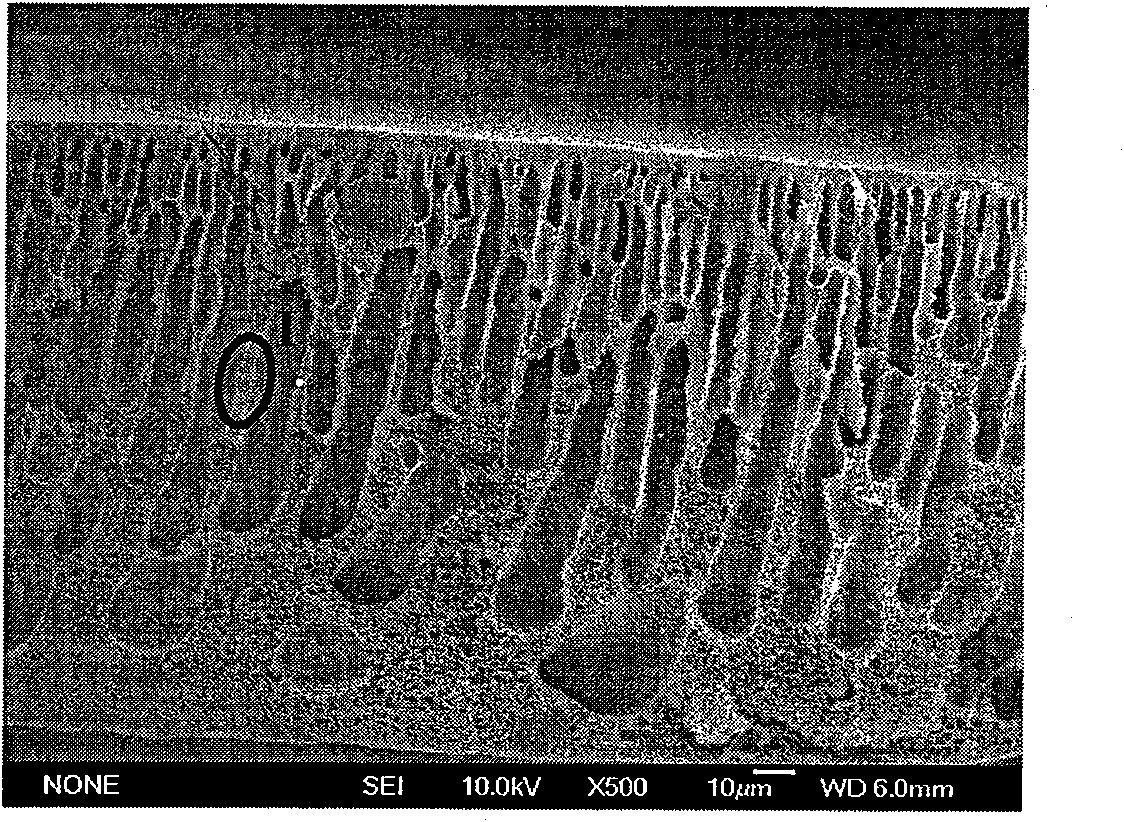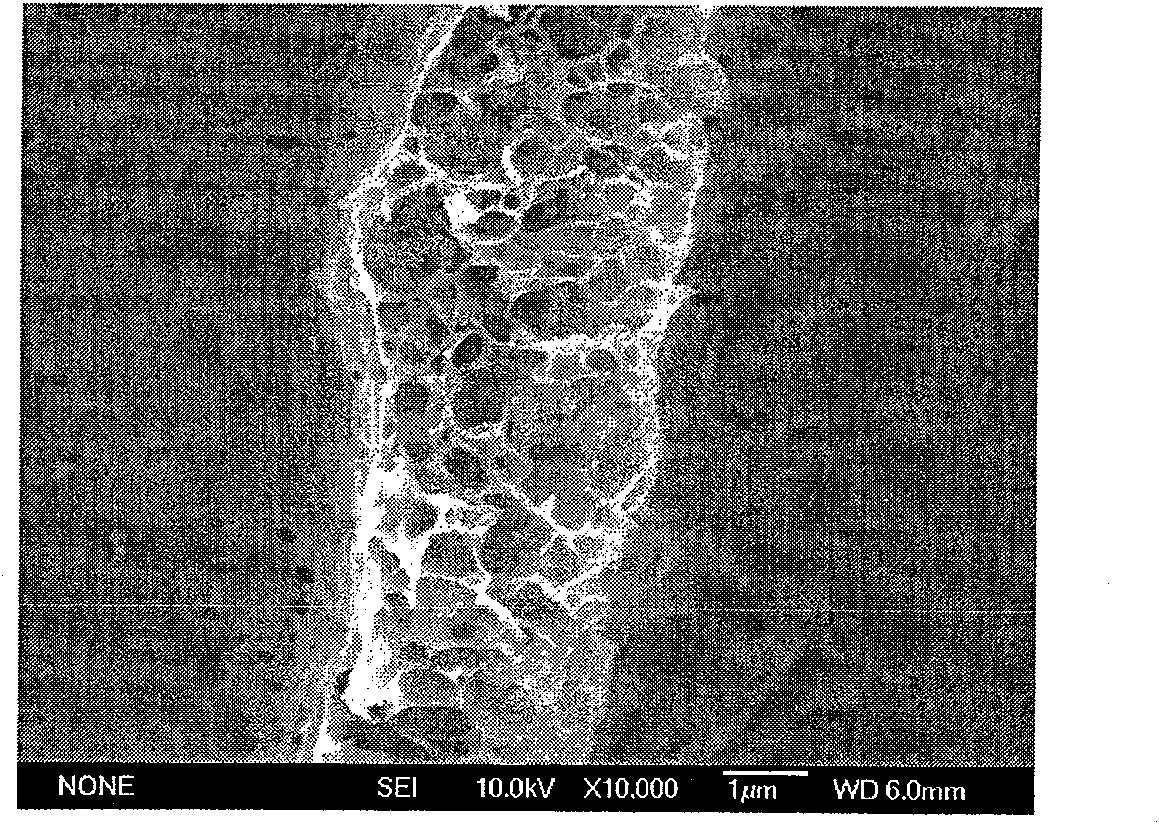Method for preparing polyaniline and nano-fibre blend composite film
A nanofiber and polyaniline technology, which is applied in the field of ultrafiltration composite membrane preparation, can solve the problems of not seeing polyaniline nanocomposite membranes, and achieve the effects of improved anti-membrane fouling ability, simple process, and easier cleaning
- Summary
- Abstract
- Description
- Claims
- Application Information
AI Technical Summary
Problems solved by technology
Method used
Image
Examples
Embodiment 1
[0013] (1) Take 8.47ml of concentrated hydrochloric acid, dilute it to 100ml with deionized water, and prepare a 1M hydrochloric acid solution; measure 2.92ml of aniline and dissolve it in 100ml of 1M hydrochloric acid solution to prepare a 0.32M aniline hydrochloric acid solution, which is designated as solution A; Dissolve 1.824g of ammonium persulfate in 100ml of 1M hydrochloric acid solution to form a 0.32M solution of ammonium persulfate in hydrochloric acid, which is referred to as solution B; quickly mix the two solutions of A and B, shake for 30 seconds, and let stand for 4~ 6 hours; use a 0.22 μm microporous membrane to filter and separate polyaniline nanofibers, wash with deionized water, methanol, concentrated hydrochloric acid, and vacuum dry at 25°C for 4 hours to obtain polyaniline nanofibers with an average diameter of 43nm and an average length of 259nm. fiber.
[0014] (2) Take 0.15 g of polyaniline nanofibers, place them in solvent N, N-dimethylacetamide (DMA...
Embodiment 2
[0017] Prepare polyaniline nanofibers by step (1) in Example 1; Take polyaniline nanofibers 0.015g, place solvent N, in N-dimethylacetamide (DMAc) 8.485g, through magnetic stirring 120r / min and Under the condition of an ultrasonic frequency of 45 Hz, the nanofibers were uniformly dispersed; 1.50 g of polysulfone was added to the dispersion liquid of polyaniline nanofibers-N, N-dimethylacetamide, and stirred until it was completely dissolved to obtain 10 g of casting liquid, which was left to stand for 8 For more than an hour, remove the air bubbles in the casting solution; at a temperature of 25°C and a relative humidity of 60%, scrape a film on the glass plate with a scraper knife to control the thickness of the film to 300 μm; after 30 seconds, immerse the glass plate in Stand in deionized water at 25°C for more than 4 hours to obtain a polyaniline nanofiber blended composite membrane, which is preserved by immersing in pure water.
[0018] The prepared polyaniline nanofiber...
Embodiment 3
[0020] Prepare polyaniline nanofibers according to step (1) in Example 1; Weigh polyaniline nanofibers 0.12g, place in solvent dimethylformamide 8.68g, under the conditions of magnetic stirring 150r / min and ultrasonic frequency 45Hz, nanometer The fibers are evenly dispersed; add 1.20 g of polysulfone to the polyaniline nanofiber-dimethylformamide dispersion, stir until completely dissolved, and obtain 10 g of the casting solution, and let it stand for more than 8 hours to remove the bubbles in the casting solution; At a temperature of 24°C and a relative humidity of 45%, use a scraper to scrape a film on a glass plate to control the thickness of the film to 300 μm; after 30 seconds, immerse the glass plate in deionized water at 24°C and let it stand for more than 4 hours , to obtain polyaniline nanofiber blended composite membrane, immersed in pure water for storage.
[0021] The prepared polyaniline nanofiber blended composite membrane has a pure water flux of 344-689L / (m 2...
PUM
| Property | Measurement | Unit |
|---|---|---|
| diameter | aaaaa | aaaaa |
| length | aaaaa | aaaaa |
Abstract
Description
Claims
Application Information
 Login to View More
Login to View More - R&D
- Intellectual Property
- Life Sciences
- Materials
- Tech Scout
- Unparalleled Data Quality
- Higher Quality Content
- 60% Fewer Hallucinations
Browse by: Latest US Patents, China's latest patents, Technical Efficacy Thesaurus, Application Domain, Technology Topic, Popular Technical Reports.
© 2025 PatSnap. All rights reserved.Legal|Privacy policy|Modern Slavery Act Transparency Statement|Sitemap|About US| Contact US: help@patsnap.com


